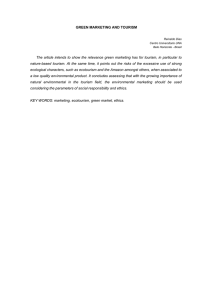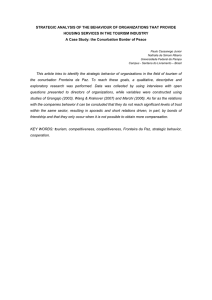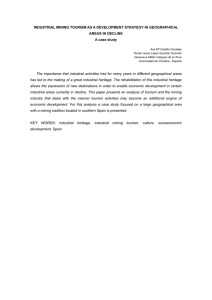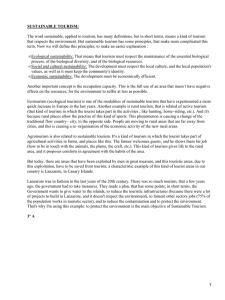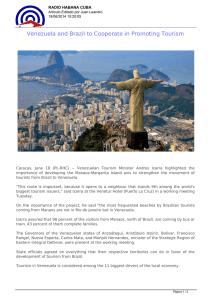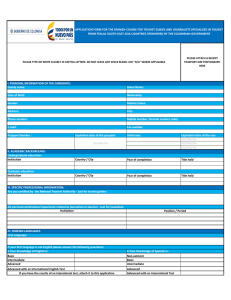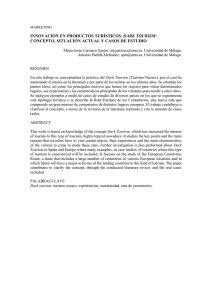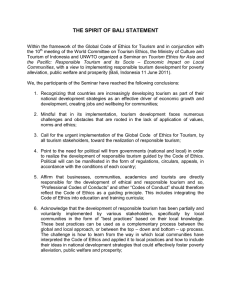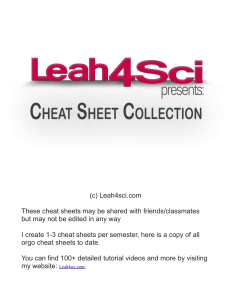New Tourism Product Development Process in - ECEAT
Anuncio
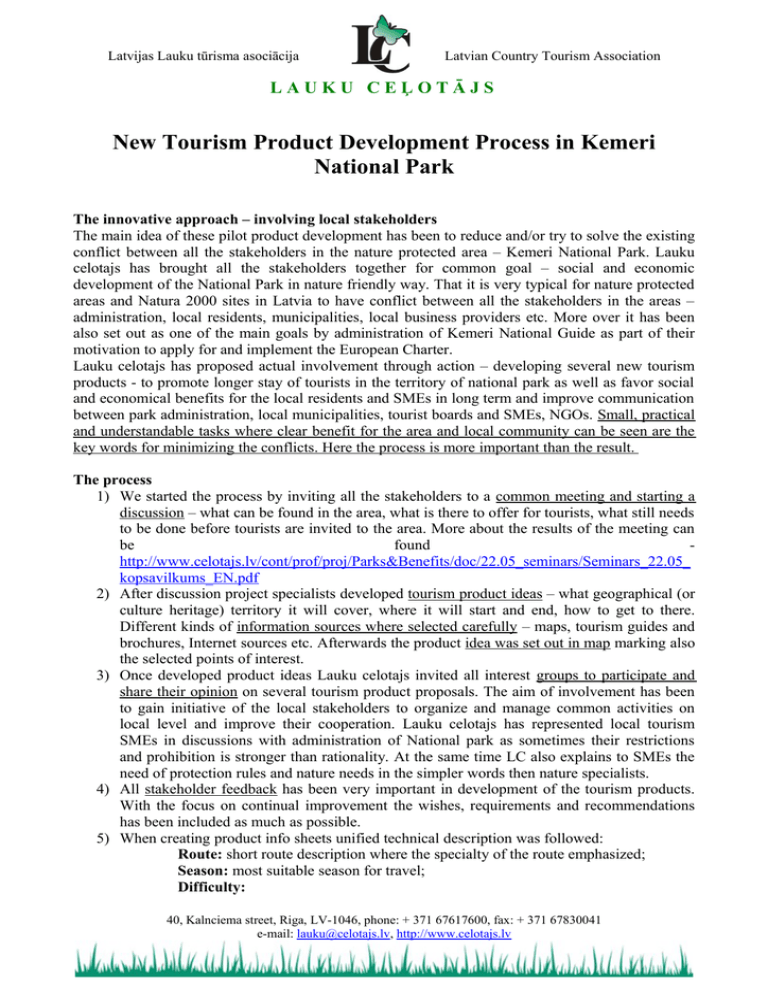
Latvijas Lauku tūrisma asociācija Latvian Country Tourism Association LAUKU CEĻOTĀJS New Tourism Product Development Process in Kemeri National Park The innovative approach – involving local stakeholders The main idea of these pilot product development has been to reduce and/or try to solve the existing conflict between all the stakeholders in the nature protected area – Kemeri National Park. Lauku celotajs has brought all the stakeholders together for common goal – social and economic development of the National Park in nature friendly way. That it is very typical for nature protected areas and Natura 2000 sites in Latvia to have conflict between all the stakeholders in the areas – administration, local residents, municipalities, local business providers etc. More over it has been also set out as one of the main goals by administration of Kemeri National Guide as part of their motivation to apply for and implement the European Charter. Lauku celotajs has proposed actual involvement through action – developing several new tourism products - to promote longer stay of tourists in the territory of national park as well as favor social and economical benefits for the local residents and SMEs in long term and improve communication between park administration, local municipalities, tourist boards and SMEs, NGOs. Small, practical and understandable tasks where clear benefit for the area and local community can be seen are the key words for minimizing the conflicts. Here the process is more important than the result. The process 1) We started the process by inviting all the stakeholders to a common meeting and starting a discussion – what can be found in the area, what is there to offer for tourists, what still needs to be done before tourists are invited to the area. More about the results of the meeting can be found http://www.celotajs.lv/cont/prof/proj/Parks&Benefits/doc/22.05_seminars/Seminars_22.05_ kopsavilkums_EN.pdf 2) After discussion project specialists developed tourism product ideas – what geographical (or culture heritage) territory it will cover, where it will start and end, how to get to there. Different kinds of information sources where selected carefully – maps, tourism guides and brochures, Internet sources etc. Afterwards the product idea was set out in map marking also the selected points of interest. 3) Once developed product ideas Lauku celotajs invited all interest groups to participate and share their opinion on several tourism product proposals. The aim of involvement has been to gain initiative of the local stakeholders to organize and manage common activities on local level and improve their cooperation. Lauku celotajs has represented local tourism SMEs in discussions with administration of National park as sometimes their restrictions and prohibition is stronger than rationality. At the same time LC also explains to SMEs the need of protection rules and nature needs in the simpler words then nature specialists. 4) All stakeholder feedback has been very important in development of the tourism products. With the focus on continual improvement the wishes, requirements and recommendations has been included as much as possible. 5) When creating product info sheets unified technical description was followed: Route: short route description where the specialty of the route emphasized; Season: most suitable season for travel; Difficulty: 40, Kalnciema street, Riga, LV-1046, phone: + 371 67617600, fax: + 371 67830041 e-mail: [email protected], http://www.celotajs.lv Latvijas Lauku tūrisma asociācija Latvian Country Tourism Association LAUKU CEĻOTĀJS . easy – suitable for wide target group. Usually route goes along relatively flat area and no special navigation abilities needed; .. medium – longer routes and more difficult; ... difficult – route goes along steep and high river banks and/or requires physical preparation for the length of the route; Duration: approximate time in hours or days to make the route for an “average” tourist; Road cover: road cover along the route. Gravel and paved road proportion stated; Beginning/end: the place where to start and end the trip; Markings: described the format of the markings of the route if one exists; Route: main places and distance between them listed as well as total distance of the route. Note that it is the distance between the places and real distance of the route usually is longer; Alternatives: other options of the route in the area suggested; Note! Useful tips provided Logistics: how to get from the end of the route back to the beginning if needed; Places of interest: nature and culture heritage objects to see on the way; Cartographic information and pictures representing the route. 6) The products and their development process has been presented and agreed also with governmental Nature Conservation Agency. 7) Developed product info sheets with description of the route was sent out to the project stakeholders – tourism service providers, tourism information boards, municipalities, representatives of administration offices of nature protected areas etc. to comment and give their feedback about the tourism products as well as offer their services (dining, accommodation, country bounty, special tourism attractions, craftsman, guide services etc.). The feedback was added to the tourism products; 8) Meanwhile the project staff of Lauku celotajs has done local and national inspection field visits gathering and sharing experience on project development in protected areas. Each tourism route has been inspected several times and meetings with tourism providers held to indentify pros and cons of the tourism products. Inspections held in different seasons of the year have provided project specialists with valuable information to improve the product descriptions. The information gathered on good practice examples have been introduced in the tourism products of Kemeri National park as well as will serve as basis for development of Latvian national park guide. The innovative choice of IT technologies Products have been developed in easy to use layout – easy to adapt for the local tourism SMEs in further development as well as colorful, attractive and educating for tourists to use. It is innovative approach in developing and targeting the tourist to provide small tour brochure/guide to print out and travel – follow the suggestions of the tour description or combine it with any other travel information. Technical implementation of the product info sheets were carefully selected to minimize the costs for project participants and especially local service providers to adopt the technology and solutions developed during the project. Instead of outsourcing sheet design to professional designers, it was decided to develop template and product sheets only using open source/free development tools and royalty free fonts and graphics: • Open source package Scribus (http://www.scribus.net/) was selected as a development tool • Custom royalty free number and icon font was created using another open source tool (http://fontforge.sourceforge.net/), to simplity development of additional sheets 40, Kalnciema street, Riga, LV-1046, phone: + 371 67617600, fax: + 371 67830041 e-mail: [email protected], http://www.celotajs.lv Latvijas Lauku tūrisma asociācija Latvian Country Tourism Association LAUKU CEĻOTĀJS • Special simplified product info template was designed to allow non-professional designer to work with the info sheets. • Together with the final version of product sheets (printed or PDF), also source package is available, which allows to use this product free of charge as a starting point for a new product developments. As a result unique package will be available to the local tourism service providers, which allows with zero investment in professional design tools and/or outsourcing contracts, to allow in short time to create professional looking, carefully developed with sustainability and nature protection in mind and tested on real tourists products. Why us? Lauku celotajs is a rural tourism association with more than 16 years of experience in tourism market therefore we have good knowledge of what tourist is looking for and can suggest the most sustainable way of new product and offer development. It’s our input in development of nature tourism products targeted to tourists. It is innovative way to address the tourists – describing the area, how to travel, what to see, how to get around, giving the idea, inviting to the area. Products educate the tourist in a new way addressing the tourist on nature conservation – all products includes information about the national park and the nature values there, suggests the way of transportation and behavior once in nature. Next developments For the RP3 and RP4 we plan to test the products on tourists by publishing the products for free download online at website of Lauku celotajs, KNP administration and other websites and gather the feedback – to summarize what is in interest of tourists, where they want to go, what to do, how to plan and combine the travel in the territory. As all of the products are available in LV, EN, DE and RU languages the experience of such pilot products will be transferable in all Baltic Sea region as good practice example. Furthermore Lauku celotajs in close cooperation with administration of Kemeri National park has planned to develop Kemeri national park guide - brochure which has never existed before and would include all the products developed during this project, which all are innovative and can be seen as transnational approach easily. The languages - LV and EN. Target - local and international tourists. Also Lauku celotajs has planned to develop Latvian national park guide - this also would be really innovative guide, as never existed before in any Baltic country. Even more - our approach would be innovative, as normally a tourism organization never develop a guide trough the national parks even in European countries - it usually are developed by "nature people" - biologists, botanics etc. so they do not really "see the tourist" in reality. We would develop it together with the Latvian National parks, which would create a lot of new approach and we would include the Europark charter points - so we would take also other parks closer to the European charter network. We would elaborate products nature friendly for other parks as well and we would include within the project elaborated products in Kemeri. The languages - LV and EN. Target - local and international tourists, who are interested in nature and see National park as added value for the destination, they would be guided in a nature friendly way thereby educated. This project is partly financed by the European Union (ERDF) within the Interreg IVB Programme 40, Kalnciema street, Riga, LV-1046, phone: + 371 67617600, fax: + 371 67830041 e-mail: [email protected], http://www.celotajs.lv
